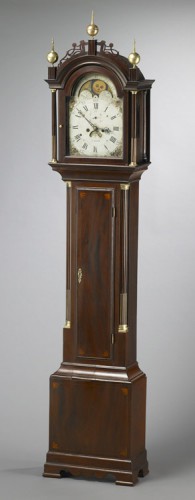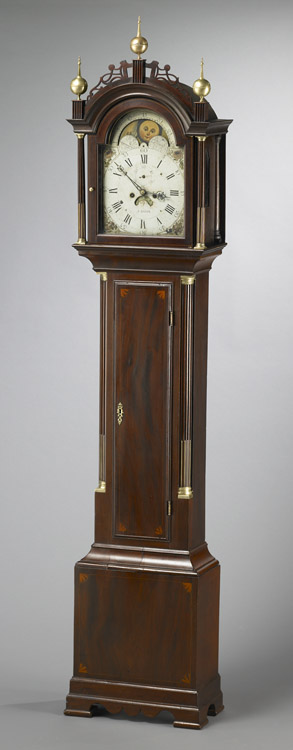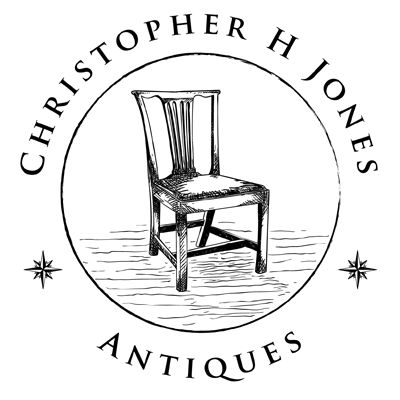 Object: Tall case clock with eight-day brass movement
Object: Tall case clock with eight-day brass movement
Maker: Dial signed “E[lnathan]. Taber” (1768-1854); case attributed to the Fisk family
Origin: Roxbury, Massachussetts
Date: 1795-1800
Dimensions: Height 95″, width 20 1/4″, depth 9 7/8″
Medium: Mahogany and mahogany veneers with light and dark wood and brass inlays primary; white pine secondary
Commentary: This handsome tall clock by Elnathan Taber (1768-1854) is an early and fine example of the “Roxbury” tall clock developed by the Willard family of Massachusetts, who dominated New England clock making for fifty years beginning in the last decade of the eighteenth century.1 In 1787, Dartmouth, Massachusetts native Elnathan Taber entered Simon Willard’s Roxbury shop at the age of 19 and began an apprenticeship that lasted until about 1793. Taber then established his own Roxbury shop, where he made the movements for tall cloks, shelf clocks and, eventually, banjo clocks, as well. Taber’s cases, like those used by Willard and others who trained with them, are often difficult to differentiate one from another.2 Simply put, the Willards and their former apprentices patronized the same cabinet makers and hardware suppliers, resulting in a degree of standardization that increases the importance of a dial signature when attributing the movement. It has been suggested that a member of the Fisk family was responsible for crafting the case, for it shares numerous affinities with examples made by the Fisks for the Willards.3
This clock dates to the period between 1795 and 1800 as suggested by the moldings on the waist door, the early bracket feet with the shaped skirt, and the restrained yet sophisticated veneering. Inside the door, Taber pasted the lower portion of Simon Willard’s instruction label. First printed in 1796 by Isaiah Thomas, Jr. of Worcester, it included a lengthy advertisement for Willard’s clock-making business, and appeared on Willard clocks until about 1805 . In this particular instance, Taber clipped and discarded the Willard-related text from the label, and pasted the pertinent “Directions To Set Clocks In Motion” inside the door. Although Willard might have frowned upon Taber for the practice, he likely was not aware of it on this exported clock.
PROVENANCE:
The clock descended in the Beverley family of “Blandfield,” Essex County, Virginia, where it remained from the late eighteenth century until the late twentieth. This is likely the “clock $30” recorded in the 1800 estate inventory of Robert Beverley (1740-1800). Upon the 1766 death of his father William, Robert Beverley become one of colonial America’s wealthiest men, owning thousands of acres of land in eastern Virginia and in Augusta County in the Shenandoah Valley. In 1763, Beverley married Maria Carter–daughter of Landon Carter of nearby Sabine Hall–with whom he had sixteen children. About 1769, the Beverleys began construction of a new dwelling house at Blandfield, replacing his father’s older residence. The project occupied them for a decade and strained even their ample purse. When completed, the five-part Palladian house was among Virginia’s most elegant, and the family spared little expense in furnishing it from a variety of sources, both local and foreign.
Pre-1800 New England tall clocks have documented Southern provenance are relatively scarce.4 Although scattered records document New England clock makers connections with merchants in Maryland and Virginia, the clock’s exact path to Blandfield is unclear.5 Certainly, the Willards and their former apprentices exported numerous clocks to the South, and examples bearing the names of Virginia retailers occasionally surface. By 1804, Richmond, Virginia clock maker William McCabe was retailing Roxbury clocks to Southern clients. Similarly, the Munroe family of New-England clock makers were well entrenched in the Virginia and Maryland market: Daniel Munroe, Jr. (1753-1848) apprenticed to Simon Willard between 1789 and 1796, and the following year set up his own shop in nearby Concord. There he was joined by brother Nathaniel in 1799 and William in 1801. The family soon recognized the untapped potential of the South, and in 1805 Nathaniel set off for Norfolk, Virginia, where he advertised in the local paper that he had taken a shop. Soon, he expanded the business into Baltimore. From these two locations he sold clocks that his brothers had made back in Massachusetts, both wholesale and retail.
The Beverly family papers are far from complete, yet document Robert’s mercantile connections that spanned the Atlantic, and regularly placed him in touch with merchants and factors in Alexandria, Baltimore, Richmond, Norfolk and Philadelphia. Robert Beverley’s unpublished letterbook from 1794-1797 (now held by descendent) t [NOTE Another letter book, held by the Library of Congress, frequently cited in period studies, covers period 1761 – 1800, so there is some overlap], leave no doubt that Beverley owned a tall case clock by 1795, for on February 16th he wrote Jesse Hollingsworth of Baltimore concerning goods he had ordered, and noted “at the same time be pleased to forward by some gentlemen in the stage cat gut sufficient to hang the weights of my clock- they may be directed to the care of Mr. William Glassel in Fredg.” Beverley repeated the request in another letter to Hollingsworth dated April 1795 reminding him to send “catt gut for two clock strings.”
The clock remained in the Beverley family for nearly two centuries. Prior to sale of the plantation and the dispersal of its contents in 1983, Colonial Williamsburg photographed the interior with the furnishings in situ. Photographs of the parlor show the clock standing to the left of the chimney. After the sale, a small group of objects were lent to the Colonial Williamsburg Foundation, while others, including the clock, were divided among the various family members.
Condition: This tall case clock survives in fine condition and retains its original feet. The only restorations are to the hood door, the pierced fret, plinths, and finials. All case work was undertaken by furniture conservator Rick Vogt of Richmond, Virginia, in January of 2008. Minor losses to the waist door moldings were replaced, the plinth of the case re-glued, and the missing case bottom and foot blocks replaced.
The prototype for the fretwork and plinths was provided by Chris H.Bailey, Curator of the American Clock & Watch Museum in Bristol, Connecticut. However the rabbet for the original central plinth surviving on this clock was slightly larger than the example found on the museum prototype and has been restored accordingly The hood door is restored based on documented Roxbury examples
The painted dial survives in unconserved condition with later black overpaint to the numerals and lettering. Half a century or more ago, an amateur Virginia restorer who was unfamiliar with the name Elnathan Taber incorrectly repainted the signature as “F. TABER”. Based upon a photograph, Chris H. Bailey commented: “I can tell with reasonable certainty by examining your photos that what you are now seeing is a relining of the original signature.” The same restorer is likely responsible for over-painting the Roman numerals, as well as losses to the moon dial.
In January of 2008, clock conservator Douglas Whitesell of Middleburg, Virginia, cleaned and calibrated the movement.
Notes:
1 Philip Zea and Robert C. Cheney. Clock Making in New England 1725-1825. Sturbridge, MA: Old Sturbidge Village, 1992, page 29.
2 Ibid, page 65. For an example of the stylistic parallels that existed among the Willard apprentices, see figures 3-3 and 3-4, pages 64 and 65 respectively.
3 Correspondence between Chris H. Bailey, Curator of the American Clock & Watch Museum (Bristol, Connecticut), and Christopher H. Jones, December 19, 2007.
4 An 1805-1815 Roxbury or Boston, Massachusetts, tall case clock with the dial marked “William McCabe/RICHMOND” is in the collection of Colonial Williamsburg and is discussed by Ronald L. Hurst and Jonathan Prown. Southern Furniture 1680-1830: The Colonial Williamsburg Collection. Williamsburg, VA: The Colonial Williamsburg Foundation, 1997, catalog number 171, pages 567-571.
5 As early as 1806 the Boston firm of Munroe and Whiting was distributing Roxbury-style clocks in the South with sufficient success that around 1816 Munroe relocated along with his business to Baltimore. Additionally, the Museum of Early Southern Decorative Arts recorded a Willard clock in Charles Town, Virginia. See John Bivins. “A Catalogue of Northern Furniture with Southern Provenances.” Journal of Early Southern Decorative Arts. Volume XV, Number 2. Winston-Salem, NC: The Museum of Early Southern Decorative Arts, November 1989, pages 43-91.
Price: Sold


